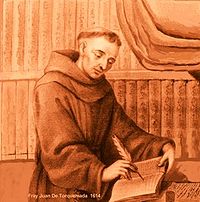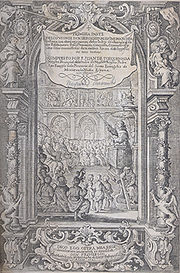
Fray Juan de Torquemada
Encyclopedia

Franciscan
Most Franciscans are members of Roman Catholic religious orders founded by Saint Francis of Assisi. Besides Roman Catholic communities, there are also Old Catholic, Anglican, Lutheran, ecumenical and Non-denominational Franciscan communities....
friar
Friar
A friar is a member of one of the mendicant orders.-Friars and monks:...
, missionary and historian in Spanish colonial Mexico
Mexico
The United Mexican States , commonly known as Mexico , is a federal constitutional republic in North America. It is bordered on the north by the United States; on the south and west by the Pacific Ocean; on the southeast by Guatemala, Belize, and the Caribbean Sea; and on the east by the Gulf of...
. He is most famous for his 1615 monumental history of the Indigenous entitled Los veinte y un libros rituales y Monarchia Indiana, commonly known as simply Monarchia Indiana ("Indian Monarchies"). This work, which has never been published in English, was reprinted in Spanish in 1969 as volumes 41 - 43 of the Biblioteca Porrua.
Life
Juan de Torquemada was born at TorquemadaTorquemada, Palencia
Torquemada is a municipality in the province of Palencia, Castile and León, Spain. According to the 2010 census , the municipality has a population of 1098 inhabitants.The village is known for its peppers, an important crop for the local economy....
between 1557 and 1565 and arrived in New Spain
New Spain
New Spain, formally called the Viceroyalty of New Spain , was a viceroyalty of the Spanish colonial empire, comprising primarily territories in what was known then as 'América Septentrional' or North America. Its capital was Mexico City, formerly Tenochtitlan, capital of the Aztec Empire...
as a child. He studied philosophy and Nahuatl at the convent Grande de San Francisco in Mexico City, where he was ordained in 1579. In 1582 he moved to the convent of Santiago Tlatelolco
Tlatelolco (Mexico City)
Tlatelolco is an area in the Cuauhtémoc borough of Mexico City, centered on the Plaza de las Tres Culturas, a square surrounded on three sides by an excavated Aztec archaeological site, a 17th century church called Templo de Santiago, a former convent, and office complexes that used to belong to...
, and he was made guardian of that convent in 1600. He also took over the administration of the Colegio de Santa Cruz de Tlatelolco
Colegio de Santa Cruz de Tlatelolco
The Real Colegio de Santa Cruz in Tlatelolco, Mexico, was the first European school of higher learning in the Americas. The school was built by the Franciscan order on the initiative of Viceroy Antonio de Mendoza and Bishop Juan de Zumárraga on the site of an Aztec school, for the children of nobles...
.
Beginning in 1604 he traveled continually on the business of his order. He was guardian of the convents of Zacatlán
Zacatlán
Zacatlán is a city, and the surrounding municipality of the same name, in the northern region of the Mexican state of Puebla. It is renowned as one of the country's foremost apple-growing regions, and is so sometimes called "Zacatlán de las Manzanas"...
(in the mountains of Puebla
Puebla
Puebla officially Estado Libre y Soberano de Puebla is one of the 31 states which, with the Federal District, comprise the 32 Federal Entities of Mexico. It is divided in 217 municipalities and its capital city is Puebla....
) and Tlaxcala
Tlaxcala
Tlaxcala officially Estado Libre y Soberano de Tlaxcala is one of the 31 states which along with the Federal District comprise the 32 federative entities of Mexico. It is divided into 60 municipalities and its capital city is Tlaxcala....
. In 1607, during the flood of Mexico City, he was asked by Viceroy Juan de Mendoza y Luna, marqués de Montesclaros
Juan de Mendoza y Luna, marqués de Montesclaros
Don Juan de Mendoza y Luna, 3rd Marquis of Montesclaros , Spanish nobleman, man of letters, and the tenth viceroy of New Spain. He governed from October 27, 1603 to July 2, 1607. Thereafter he was viceroy of Peru, from December 21, 1607 to December 18, 1615...
to reconstruct the calzadas (carriageways) of Chapultepec
Chapultepec
Chapultepec Park, more commonly called the "Bosque de Chapultepec" in Mexico City, is the largest city park in Latin America, measuring in total just over 686 hectares. Centered on a rock formation called Chapultepec Hill, one of the park's main functions is to be an ecological space in the vast...
, Misterios to Tepeyac
Tepeyac
Tepeyac or the Hill of Tepeyac, historically known by the names "Tepeyacac" and "Tepeaquilla", is located inside Gustavo A. Madero, the northernmost delegación or borough of the Mexican Federal District. It is the site where Saint Juan Diego met the Virgin of Guadalupe in December of 1531, and...
and San Cristóbal and the dams of Zumpango and Citlaltépetl, although he was not an engineer.
In 1609 he was named chronologist of the Franciscan Order.
In 1610 Torquemada oversaw construction of the monastery and church of Santiago Tlatelolco
Tlatelolco (Mexico City)
Tlatelolco is an area in the Cuauhtémoc borough of Mexico City, centered on the Plaza de las Tres Culturas, a square surrounded on three sides by an excavated Aztec archaeological site, a 17th century church called Templo de Santiago, a former convent, and office complexes that used to belong to...
. Its interior featured a grandiose altarpiece decorated with paintings by Baltasar de Echave Orio surrounding a hand-carved relief of Santiago
Saint James the Great
James, son of Zebedee was one of the Twelve Apostles of Jesus. He was a son of Zebedee and Salome, and brother of John the Apostle...
, but this was destroyed soon afterwards.
In 1614 Torquemada was elected provincial superior
Provincial superior
A Provincial Superior is a major superior of a religious order acting under the order's Superior General and exercising a general supervision over all the members of that order in a territorial division of the order called a province--similar to but not to be confused with an ecclesiastical...
of the Order of St. Francis in Mexico. He held this position until 1617.
He died suddenly in the church of Santiago Tlatelolco in 1624, while singing matins.
Works

Joaquín García Icazbalceta
Joaquín García Icazbalceta was a Mexican philologist and historian. He edited writings by Mexican writers who preceded him, wrote a biography of Juan de Zumárraga, and translated William H. Prescott's Conquest of Mexico...
in 1892), various comedies in Nahuatl, and one comedy in Spanish, Latin and Nahuatl, which, unfortunately, has been lost.
His main work is Los veintiún libros rituales i monarchia Indiana con el origen y guerras de los Indios Occidentales, de sus poblaciones, descubrimientos, conquista, conversión y otras cosas maravillosas de la misma tierra (The Twenty-one Ritual Books and Indian Monarchy With the Origin and Wars of the West Indians, of Their Populations, Discoveries, Conquest, Conversion and Other Marvelous Things of the Same Land, usually known as Monarchia Indiana) (3 vols., Seville, 1615). The first edition is rare, but the work was reprinted in Madrid in 1723 and again in a facsimile edition by Salvador Chávez Hayhoe in 1943-44.
This was the only New Spain chronicle of its time known to contemporaries. Works of Toribio de Benavente Motolinia
Toribio de Benavente Motolinia
Fray Toribio de Benavente also known as Motolinia was a Franciscan missionary and among the first 12 clerics to arrive in New Spain in May 1524.-Life and times:...
, Bernardino de Sahagún
Bernardino de Sahagún
Bernardino de Sahagún was a Franciscan friar, missionary priest and pioneering ethnographer who participated in the Catholic evangelization of colonial New Spain . Born in Sahagún, Spain, in 1499, he journeyed to New Spain in 1529, and spent more than 50 years conducting interviews regarding Aztec...
, Gerónimo de Mendieta
Gerónimo de Mendieta
Fray Gerónimo de Mendieta , alternatively Jerónimo de Mendieta, was a Franciscan missionary and historian, who spent most of his life in the Spanish Empire's new possessions in Mexico and Central America....
, Diego Muñoz Camargo
Diego Muñoz Camargo
Diego Muñoz Camargo was the author of History of Tlaxcala, an illustrated codex that highlights the religious, cultural, and military history of the Tlaxcalan people.-Life:...
and others were not available for centuries.
The book is tedious to read because of its theological digressions, contradictions and anachronisms. Nevertheless, it gathers together a large quantity of information taken from Indigenous pictographs and manuscripts and from Franciscan and other Catholic scholars. Torquemada interviewed old Indigenous people about their ancestors and recorded their oral traditions. The Monarchia Indiana is the best work on what was known of the Indigenous past at the beginning of the seventeenth century. It is considered an especially important source on the Totonac
Totonac
The Totonac people resided in the eastern coastal and mountainous regions of Mexico at the time of the Spanish arrival in 1519. Today they reside in the states of Veracruz, Puebla, and Hidalgo. They are one of the possible builders of the Pre-Columbian city of El Tajín, and further maintained...
, Pipil and Nicoya
Nicoya
Nicoya is a town in Costa Rica's Guanacaste province, and one of its most important tourist zones. It serves as a transport hub to Guanacaste's beaches and national parks. According to the 2000 census, the city's population was 13,334—second only to Liberia in the province...
cultures.
Torquemada describes the 1576 epidemic in New Spain in the following terms:
He reported that two million, mostly Indigenous, people died, according to a survey conducted by Viceroy Martín Enríquez de Almanza
Martín Enríquez de Almanza
Don Martín Enríquez de Almanza was the fourth viceroy of New Spain, who ruled from November 5, 1568 until October 3, 1580. He was subsequently viceroy of Peru, from September 23, 1581 until his death in 1583. His birthplace and origins are uncertain...
.

